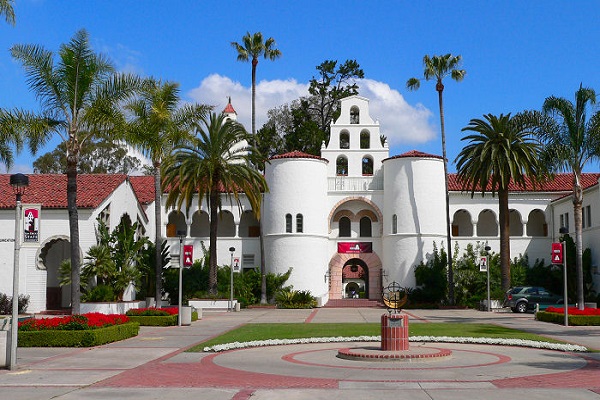San Diego State University: Reclaiming the Air, One Sonic Snapshot at a Time
The space is part of the ensemble.
It’s a fact every musician knows, but one that was doubly emphasized during the pandemic. Overnight, musicians saw beloved venues — churches, concert halls, opera houses, stadiums — shut down and lock their doors, with no idea when they would reopen.
For classical vocalist Kayla Gautereaux, the experience was visceral.
“I cannot emphasize this enough: space is so important to sound. It changes the whole ambiance of what a performer and audience member is experiencing,” said Gautereaux, an assistant professor with the Boston Conservatory. “Being ripped away from our spaces was such a blow to musicians and our ability to be creative.”
Gautereaux tried practicing in her living room, but the experience lacked warmth and ebullience. The environment felt dead. The soundwaves thunked against her walls and died.
She missed the concert hall, with the rich resonance of her voice echoing against the walls and warming the ears of an audience.
“COVID-19 stole the air from musicians,” she said.
Gautereaux, a 2014 graduate of San Diego State University’s School of Music and Dance, was sharing her disappointment with a friend and fellow graduate when she learned about the research of Chris Warren, an assistant professor of digital composition and sound design.
Long before the pandemic upended the performing arts, Warren was fascinated by the relationship between sound and space. Play a note in the middle of a field, and the soundwaves unfurl evenly across the open space until they dissipate into the air. But walk into a cave and play that same sound, it will bounce around the walls and amplify tenfold.
Warren created an algorithm that captures the sound environments of resonant spaces. His program EchoThief takes impulse responses — high resolution sonic snapshots — of any space, digitizes the exact acoustical recipe and then has the ability to apply that acoustic environment to any sound. EchoThief is so precise it measures exactly how long a sound resonates within a space before evaporating into silence.
Both an experienced musician and an avid adventurer, Warren has traveled the globe capturing sound environments — from concert halls and famous churches to lava tubes and bat caves — and replicating them for EchoThief. He’s visited the melting icebergs of Alaska, the underbelly of the Golden Gate Bridge, and an abandoned granite mine in Los Angeles. The results have been, at times, surprising. In the giant subterranean artillery batteries of an abandoned fortress in Washington, sound resonated as much as six seconds — nearly three times the reverbance of a concert hall.
The EchoThief digital library is freely available to the public online and in an app. It includes more than 100 sound environments, with another 100 dropping by the end of 2022.
“The spaces that sound happens in colors them extraordinarily,” Warren said. “Being able to control the reverberation of the sound lets us contour that sound in such interesting ways.”
EchoThief, he adds, makes these natural wonders and feats of architecture available to anyone, regardless of talent or circumstance.
Warren plans to further his EchoThief technology in a state-of-the-art sound lab in SDSU’s planned Performing Arts District. The lab will be built on its own foundation to create the most sonically isolated environment possible. He’s already highlighted it in an interactive exhibit for Carlsbad’s Museum of Making Music, and licensed it to Sony and Bethesda Game Studios — helping the companies add audio features that improve video games and virtual reality experiences.
Gautereaux recalls being in her small Boston apartment during the height of the initial COVID-19 lockdown, sitting alone in her living room but, thanks to EchoThief, sounding as if she was in large chamber hall of Saint Martin of Tours Church in La Mesa, where she performed countless concerts with the choir she co-founded — Folklore Guild, a vocal group that sang theme songs from popular video games and fantasy shows. The large stained glass windows, the pews packed with people, the crucifixes placed about the hall — all of these elements may have been missing but, if she closed her eyes, Gautereaux was back at the church, singing the “Game of Thrones” theme song as if she had never left.
“Through EchoThief, I was able to go back and visit a space that had brought me so much joy,” Gautereaux said. “It was a therapeutic experience during an uncertain time, a time when there was no way I could have experienced that environment.”

